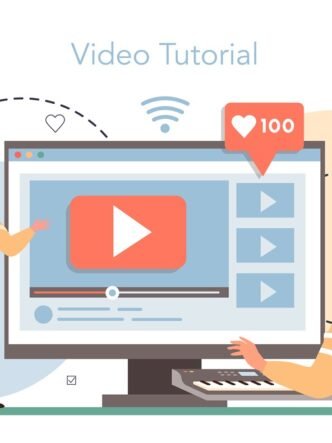If you want to attract high-quality leads and improve conversion rates, using video can help you more than other marketing methods. In a recent study for Zappos by econsultancy, it’s found that product video can increase sale between 6% to 30%.

Video has to be used strategically to be of real benefit, and this is where using the valuable information found on a video heatmap can make a difference.
What is a video heatmap?
A video heatmap is a graphical representation of data with values shown in color. A heatmap provides a summary of information by synthesizing data and presenting it in visual form. Heatmaps provide a practical way to differentiate between viewers who are interested and those who are not.
Where do you find heatmaps?
On a private hosting platform like Cincopa, every video view generates a video heatmap that shows a second-by-second view of the viewer’s behavior. The heatmap contains viewer information, contextual information, such as where and when the video was watched, and a color-coded timeline showing interaction with the video.
White, green, orange and red colors reveal the level of interaction and the ‘hotter’ the color, the greater the engagement. You can see whether viewers have skipped certain parts and rewatched others, find out how many videos viewers watched, see viewer demographics and if they clicked on a call-to-action.

You may have wondered why you should use a video hosting service if you can simply upload your videos to sites like YouTube. Using a paid video hosting service offers many benefits that free service does not, such as increased security, customization options, and in-depth analytics, including the use of video heatmaps.
Apart from offering precise performance metrics, hosting your videos on a private hosting platform also means videos are automatically adapted to suit the devices the viewer is using so they have clear quality anywhere at any time, without taking too long to load.
Key video analytics metrics
Most of us are familiar with metrics, such as impressions, views, and likes. View length is the amount of time a viewer watched a video. Different platforms have different viewing durations that count as views.
Engagement rate refers to the number of people still watching at a particular point divided by the people who started watching. Metrics such as viewer location (where they are watching from), where they are finding videos as well as what devices and operating systems they’re using are all important when it comes to making marketing decisions.

Conversion rate is one of the most important metrics because it refers to viewers who take action during or after watching a video. The better video analytics are, the more they will help you understand what is working and what isn’t so you can make changes accordingly. Heat maps present the information in a way that makes it easy to understand more about your viewers.
Taking action based on in-depth analytics
By looking at the color-coded timeline on a heatmap, you can discover information that helps you to improve your videos.
Unwatched content: If you see white on a heatmap, it indicates that a portion of the video was not watched at all. Perhaps this content needs to be left out altogether. If you see that a large percentage of your content is unwatched, you may have to start from scratch and create more engaging content.
Rewatched Content: Yellow indicates that a viewer watched content more than once. This may indicate they found it very useful and you can place more emphasis on it.
Of course, you could also find out that viewers rewatched content because it was too complex to digest the first time. You have to try and determine why viewers took certain actions rather than just making assumptions.

Viewers dropping off: If viewers are dropping off at a certain point, it could be because you went off at a tangent or became too salesy. They could also be feeling that your video is just too long.
If you overload your videos with details, you tend to lose viewers. Once you think you understand why people are dropping off, you can keep editing and test your videos to try and minimize the drop-off rates.
Viewers only watching one video: If viewers watch one video and move on, you need to think about retargeting them and encouraging them to engage again so you can start creating a relationship with them.
No clicks on call-to-action: You may find that your call-to-action is not converting. This could be because it is not clear enough and people are uncertain about what action to take. CTA at the beginning of a video works better than placing it mid-roll or post-roll.
Using demographic data: If you’re not sure about your audience, demographic data can help point you in the right direction. The only way to find out if you’re targeting the right audience is to look at demographic data.

For example, if you’re trying to target young women and they’re not watching your videos, you need to find out why. If your videos don’t seem to appeal to the right demographic, you may need to try different types of videos or distribute them differently.
Demographic data could also help you to tap into new markets. Perhaps your videos are being watched by a demographic you had not thought of targeting. Targeting them could increase conversions.
Segmenting viewers according to their responses helps you to target them more accurately. Perhaps a particular segment of your audience is interested in a specific type of video – you could use the information to target that audience segment with the type of content they want to watch.
The importance of viewer location: If your business only serves specific areas, it doesn’t help if you’re not reaching viewers in those areas. You have to find ways to attract them, such as using paid advertising.
Traffic sources: Finding out how viewers found your video can improve your efforts at promotion. You need to know which platforms generate views most effectively. Are viewers being referred from your social media channels? Are they coming directly to your website from organic search results?
Using data like this, you can test different traffic sources and make adjustments to improve your results. If your videos are not driving people to your website, consider using a video hosting platform so that your videos contribute to your website SEO.

Devices people use: If viewers are watching mainly from mobile devices, you need to optimize content for these, such as creating short, fast-loading videos and suitable CTAs.
Using analytics to improve return on investment
Whether you’ve created a short explainer video, a product demo or a video testimonial, you need to know what impact it is having on your audience.
Many video marketing platforms provide analytics of some kind or another but knowing how to use these analytics can help you to create campaigns supported by the data and optimize what you’ve measured. Resourceful insights on performance over time help you to decide how to spend your money more effectively by figuring out which campaigns work best.
It is not enough to use video – it has to be used strategically. By using video analytics, such as heatmaps, you take away the guesswork. You can see your return on investment by matching specific videos to your marketing goals and measuring your results. In this way, you can keep making changes and testing them to improve your marketing strategies.









